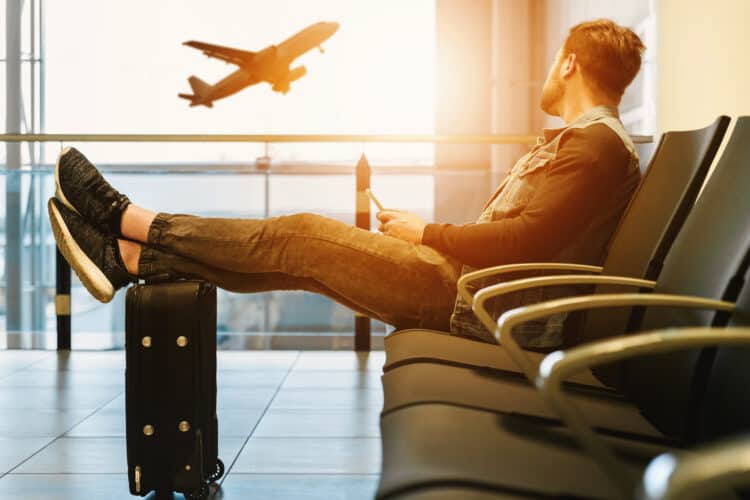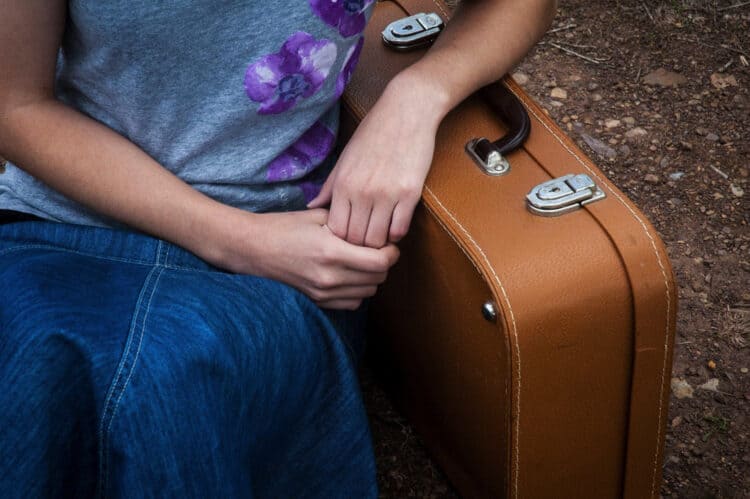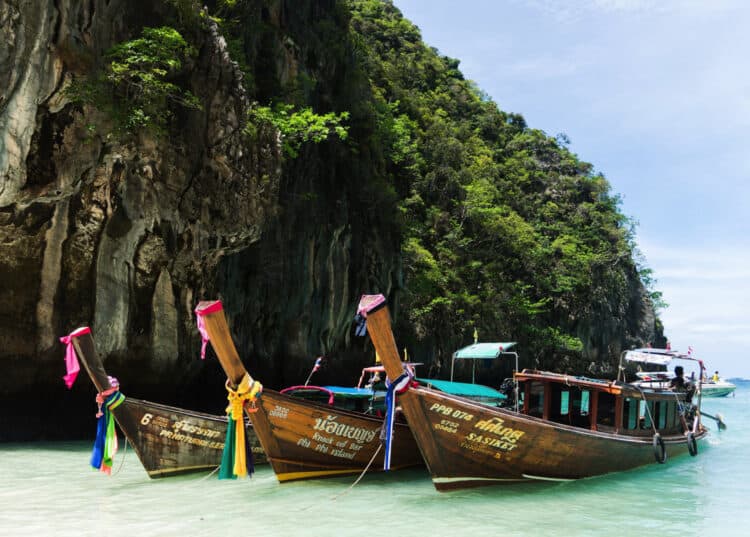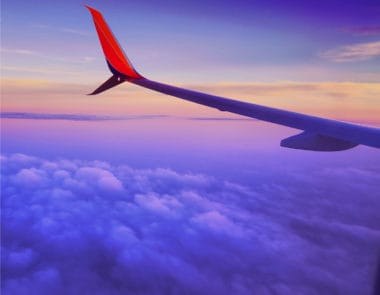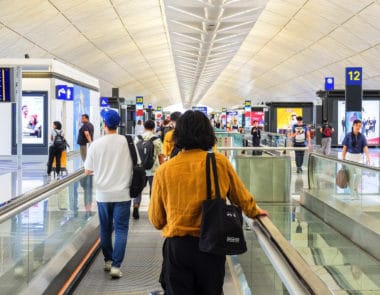49 Best Travel Tips to Save Time, Money, & Stress in 2025
Traveling locally, across the country, or to another continent is an exciting way to form memories and experience other cultures. But an awry trip can usher in unnecessary stress, expenses, and potential regrets.
These travel tips can help you have a successful trip from the initial planning stages, as you pack your bags, and once you reach your destination.
Table of Contents
Best Travel Tips While Preparing for a Trip
This collection of tips covers just about everything you should consider when traveling and before you go. You are most likely practicing some of them, making them a good reminder, and others can help prevent uncommon travel surprises.
1. Book At Least Six Weeks in Advance
Instead of carving time out of your schedule to book your trip at a specific date or time (such as Tuesdays at 3 a.m. using a private browsing session to find discounted fares), a more effective strategy is researching travel options at least four to six weeks in advance.
You can still find cheap flights and ideal flight times at least six weeks before departure. Getting on the hunt two or three months before major holidays is also good.
Last-minute travel savings are possible but you may be unable to get a desired departure time, layover window, or destination. Waiting until the final days can be worth it if you have a flexible schedule and are open-minded about where you travel to.
Learn More: Best Days and Times to Book Flights
2. Travel in the Off-Season or Shoulder Season
Avoiding the peak travel season is one of the easiest ways to pay less for flights and lodging. You also will enjoy smaller crowds and the weather can still be decent for your intended activities.
For example, visiting Spain is delightful in March and April but travel prices are elevated during Semana Santa (Holy Week) when most cities have processions that virtually shut down the city.
Another example is visiting a beach town during the shoulder season. The shoulder season is the time between the peak and the offseason. So you could take a trip to Cape May, NJ from the middle of May to the end of June instead of during the July/August peak. The weather is still good enough during the shoulder season to enjoy most peak-season activities.
3. Compare Multiple Booking Sites
Comparing prices from several travel booking sites can help you find the best rate within minutes. Airlines, hotels, and rental cars offer several slots to third-party booking sites and you can pay less than booking directly from the carrier.
It’s worth your time to check prices directly from the carrier website but also from one or more third-party booking sites (online travel agencies or OTAs) like Hotels.com, Kayak, or Google Flights.
The Vacationer Tip
Along with looking for the best flight schedule and prices, you can use our guide to help find the best seats on the plane and book them for cheap or for free.
4. Book Directly from the Travel Provider
While you can find discounted prices through online travel agencies and third-party booking sites, booking directly from the airline, hotel, or rental car agency provides more protection if you must cancel or reschedule. This is especially important for flights and the 24-hour cancellation rule.
With third-party reservations, you may be locked into a particular itinerary that could be non-refundable or non-changeable. You will need to call the booking site to determine what your alternatives are. If you’re eligible for a refund, it can take longer to receive your funds.
5. Stay at a Hostel to Save Money
Hostels are a common and safe way to secure affordable lodging in Europe and Asia. If you’re traveling solo or in a group and okay with not having as much privacy, a hostel helps keep your travel costs down.
Despite many misconceptions, most establishments are well-run with clean bathrooms and bedding. You may also be able to get a basic breakfast at some. With that said, be sure to research your options and consider paying a little more to get more luxurious accommodations.
Related: Everything You Need to Know About Staying in a Hostel
6. Consider Vacation Rentals for Extended Stays
Vacation rental websites like Airbnb and VRBO have become immensely more popular since the pandemic as people yearned for privacy. While hotels are usually better for shorter stays as you avoid expensive cleaning fees and service fees, a vacation home or villa can be more cost-effective for extended stays.
At a minimum, a rental or an extended-stay hotel is more likely to offer a full kitchen suite that allows you to cook full meals instead of relying on packaged snacks or what fits inside the hotel mini-fridge.
Vacation rentals can also be cheaper per square foot if traveling as a family. Instead of squeezing into a hotel suite or booking multiple rooms, you have spacious accommodations. If you have small children, the extra space can keep you from losing your mind on rainy days.
The Vacationer Tip
The Vacationer’s Tip: While many people focus on spending less for flights, hotels and vacation rentals can have variable pricing. Here is how to find and book cheap hotels to enjoy clean and spacious lodging on a budget.
7. Buy Travel Insurance for Expensive or International Trips
Travel insurance is inexpensive on most itineraries and can save you thousands of dollars if your non-refundable travel is canceled or delayed for qualifying reasons.
Obtaining coverage is a good option for expensive trips. Picking up a policy can also be worth it when traveling outside the United States as you can have medical coverage and emergency evacuation benefits that your ordinary health insurance may not provide outside the country.
You should also consider booking your trips using credit cards with travel insurance coverage. These benefits are sufficient for low-cost excursions and can activate before your standalone travel insurance policy can. They can also provide complimentary rental car coverage.
The Vacationer Tip
The Chase Sapphire Reserve® offers the best credit card travel insurance benefits. Namely, you can be eligible for trip interruption and cancellation coverage of up to $10,000 per person ($20,000 per trip), primary auto rental collision damage waiver, up to $500 per ticket in trip delay reimbursement, and up to $100,000 in emergency evacuation Learn How to Apply Here
8. Consider Annual Travel Insurance Plans
If you travel regularly, an annual travel insurance policy covers multiple trips at a lower premium than buying a new policy for each trip. This is an excellent option for frequent leisure travelers and business travelers.
9. Review Airline and Hotel Cancellation Policies
Your travel plans may change unexpectedly for personal or work reasons. Before you book, take the time to review the cancellation and modification policies just to make sure they are reasonable.
You want to make sure you have a strong possibility of getting a refund or a travel credit to redeem later. Being locked into a non-refundable itinerary may not be worth the savings unless you’re booking right before you go or your travel insurance may issue a refund.
In addition to researching the cancellation policy, be sure to review an airline’s seating and carry-on policy to avoid add-on fees and restrictions.
10. Choose Early Flights
Early morning flights are the best time to fly for several reasons. First, these departures are less likely to be delayed as it’s a new travel day with rested crews and minimal weather-related interruptions.
Additionally, these flights can be cheaper as you need to arrive at the airport a little earlier. Routes popular with business travel can be an exception to this rule, but you can anticipate paying less than for a mid-day sortie.
Learn More: How to Avoid Flight Delays and Cancellations
11. Arrive at the Airport Early
Getting to the airport at least an hour before departure for domestic flights at small airports or when you’re not checking luggage. Plan on arriving at least two hours for domestic flights at busy airports, if you’re checking a bag, or traveling with small children.
What about international flights? Plan on arriving at least three hours before departure to allow additional time for a potentially longer check-in time.
Learn More: How Early Should I Get to the Airport?
12. Qualify for Expedited Airport Security
If you fly several times a year, obtaining expedited airport security credentials can help you avoid long airport security lines.
The first step is applying for a federally-administered Trusted Traveler Program, such as:
- TSA PreCheck: Enjoy expedited security at domestic airports only.
- Global Entry: Get expedited processing at customs lines on international flights plus TSA PreCheck benefits.
- NEXUS: Ideal for travel between the U.S. and Canada. It also includes Global Entry and TSA PreCheck benefits.
Several rewards credit cards are offering free Global Entry and TSA PreCheck application fee credits to save a few dollars.
In addition to Trusted Traveler programs, you can also shave a few minutes off security wait times with CLEAR at select major airports and stadiums. Where available, this pre-security program can help you reach the expedited TSA security lines sooner.
Getting a Redress Number can help those who frequently have boarding pass issues, are subject to additional security screenings (including having SSSS on their boarding pass), and those who experience delayed or denied boardings.
Learn More: How to Get Through TSA Airport Security Faster
13. Relax at an Airport Lounge
If you have a long layover or arrive at the airport several hours later, visiting an airport lounge (like a Centurion Lounge) can help you grab a complimentary meal and drink, and recharge your devices. You can also have a comfortable place to sit and the luxury lounges offer spa treatment, sleeping rooms, and shower suites to clean up.
Single-day passes are pricey but there are several credit cards with lounge access. Most lounges allow entry for the primary cardholder and up to two guests complimentary up to three hours before your next flight’s departure.
The Vacationer Tip
Airport lounge access is just one way to reduce air travel stress. Check out our article for additional suggestions.
14. Check Your Passport Expiration Date
Some countries and airlines won’t let you travel if your passport expires within six months. If you’re planning a trip, see if your passport is expiring soon to prevent delaying your trip.
Consider renewing your passport early if you’re approaching the six-month expiration window as the passport processing times can take up to 13 weeks to receive your new document. You can pay extra for expedited processing but the process can still take several weeks.
After submitting your renewal request, you can check your passport application status online.
Finally, use our How to Take Your Own Passport Photo guide to simplify things when applying or renewing.
15. Don’t Go Into Debt for Vacation
As much as you’re earning to get away on a dream trip, it’s probably not worth going into debt for. Whether your bank is offering a vacation loan or you intend on carrying a credit card balance (even with a 0% APR), borrowing money to travel can backfire.
Instead, look for the best options within your spending power. Consider setting aside money each month and delaying your trip if necessary.
In addition to saving up for travel in a dedicated savings account, you can use travel rewards credit cards to redeem points to defray purchases. Some cards offer annual statement credits that reimburse eligible travel bookings.
Additionally, airline credit cards and hotel credit cards also offer complimentary benefits to spend less.
The Vacationer Tip
Making a travel budget can help you plan for travel expenses so you’re not nervous about running out of cash while you travel or having regrets once you return home.
16. Exercise and Stretch
Once you depart for your trip, be sure to stretch and perform basic exercises as time and space permit. It can be as basic as stationary stretches while sitting in your seat to walking the airport terminal. If driving, stay outside for a few extra minutes at the gas station or rest area.
Stretching and being active once you arrive is also beneficial and can help you sleep better.
Best Travel Tips for Packing
17. Only Bring a Carry-On
When possible, only bring a carry-on to avoid lost or missing checked luggage. You can also avoid checked baggage fees and excessive weight charges if you overpack. Using the best carry-on can help you find the perfect soft or hard-sided luggage to fit your travel gear.
The Vacationer Tip
If you need to check a bag, it most likely won’t get lost but could get delayed. Here’s our helpful guide on what to do during baggage delays.
18. Pack as Light as Possible
Packing is stressful; Many people overpack to ease their anxiety, which sometimes means bringing extra suitcases or paying to check a bag. Write down everything you think you need on your packing list. After it’s complete, cut it down to the bare minimum.
Pack underwear and socks for the number of showers you expect to take; Add an emergency pair for every five or so days of your trip. Shirts and pants can usually be worn multiple days in a row. If your accommodation has a washing machine, you can pack even less.
19. Carry-On Overnight Travel Essentials
You never know when a flight delay will turn into spending the night in the terminal or at a nearby hotel. While the airline may provide meal vouchers, you should pack these travel essentials to freshen up:
- A change of clothes, especially extra underwear and socks
- Powerbank (they cost about $20 and have several phone/tablet recharges)
- Toiletries
- Travel charger
Even if you’re not stuck somewhere overnight, these small and compact items can also help you rest while on the road:
- Earplugs (great for plane rides and noisy hotels)
- Eye mask
- Noise-canceling earbuds or headphones
- Travel blanket
- Travel pillow (see the best travel neck pillows)
The Vacationer Tip
Adding these carry-on essentials to your packing list can prepare you for nearly any change of plans and to weather a long layover or flight.
20. Don’t Forget a Power Adapter
A power adapter is essential in most foreign destinations to charge your devices. Traveling to Canada or Mexico is an exception as the standard voltage is 120v and these countries have the same outlet design as the United States. Check to see the adapter requirements for the country you are visiting before leaving.
The Vacationer’s Phil Dengler recently visited South Africa and needed a Type M adapter. He purchased this Ceptics International Power Plug Adapter Travel Set, which includes 13 adapters for just about every foreign country.
21. Use Packing Cubes
There are a couple of ways to organize your travel luggage to squeeze everything in. Your bag may include built-in storage compartments or you might roll up clothing and put them in packing cubes or vacuum storage bags. If you’re on a budget, rubber bands or plastic bags can also do the job. I recommend the following packing cubes: Veken 6 Set of Various Colored Packing Cubes.
The Vacationer Tip
Packing for a vacation can feel like a fine art at times, even as a seasoned traveler. Our travel packing list can cover everything you need to bring so you don’t forget and have to buy something along the way.
22. Bring an Empty Water Bottle
For over 20 years, it’s become ingrained for air travelers to pack liquids in containers containing no more than three ounces. This security rule means you can’t bring a filled water bottle through airport security, but you can bring an empty one.
Most airports have filtered water dispensers in the post-security terminal that you can fill up your bottle with and avoid paying big bucks for bottled water. You also won’t struggle to stay hydrated during your journey.
If you’re driving, consider bringing a travel water filter or a portable filter that you can use in your hotel room to pay pennies for filtered water.
23. Dress Comfortably for the Flight
You should dress comfortably for the plane ride. Dressing in layers with a light jacket or a travel blanket can help you stay warm if the cabin is cool. Bringing travel slippers or slip-on shoes on long-haul flights is another overlooked comfort hack. Wear sweatpants instead of jeans.
24. Bring Duplicate Travel Documents
Take a few minutes to photocopy your critical travel documents such as your government-issued IDs and passport. Be sure to keep these papers separate from your originals in case one set gets lost.
Once you arrive at your destination, you may decide to go out in public with your duplicates and keep your originals plus at least one payment card in the room safe. That way, a pickpocket doesn’t run off with the more valuable set and you still have a way to make purchases.
Taking it a step further, write down your credit card numbers and the emergency contact number if you need to call and cancel if your plastic goes missing. If you don’t have a phone number, you can also look for a pay phone that should have a toll-free number to contact Visa or Mastercard to cancel your card.
25. Keep Valuables at Home and Bring a Lock
Unless it’s necessary to bring them along for a business function or a personal event, leave your valuables at home. The hassle of keeping them secure and the risk of losing them may not be worth the replacement cost.
This includes your fine jewelry, watches, and high-end electronics that are nice to use but optional for this trip. Additionally, these items can make you a target for thieves.
The Vacationer’s Phil Dengler also recommends bringing a luggage lock or a standard combination lock.
26. Install a Luggage Tracking Device
Bluetooth tracking devices like the Apple AirTag are a small and easy way to see where your carry-on and checked luggage are at all times. A single piece is about the size of a coin and costs $30 or less.
27. Bring Comfy Walking Shoes
Most of the world walks more steps than we do daily. Therefore, it’s essential to pack at least one pair of comfortable shoes or sandals to stroll the streets of your destination. Comfortable footwear is also a must-have if you’re staying stateside.
28. Keep a Travel Journal
Consider packing a notebook or diary into your carry-on. Handwriting your favorite travel memories in a journal is an easy way to remember the intricacies that you may struggle to remember years later when you reflect.
For example, you can write down what you did each day along with exciting facts. Having everybody share their favorite activity for the day is another way to use this journal.
Best Travel Tips for Once You Arrive
29. Learn the Local Customs
Words and expressions can have different meanings where you’re traveling to. It’s also a good idea to know some of the common phrases and customs the locals practice so you can have a basic conversation.
You can research these details online or in a guidebook.
30. Dress As a Local
Blending in with the crowd can help prevent unwanted attention from panhandlers and pickpockets. For example, don’t wear revealing clothing when the culture favors pants or long dresses. Researching fashion advice for your destination is your best option.
31. Be Wary of Local Scams
Brushing up on the latest tourist scams can help you avoid bad situations. A recent travel guidebook is a reliable way to find the most common tactics for your destination. Two to look out for are unofficial taxis and fake wifi hotspots.
32. Consider Wearing a Money Belt
Long-time travelers have a love-hate relationship with money belts as they point you out as a tourist if you’re constantly reaching for it in public. Additionally, wearing the belt all day can be a nuisance as it’s an extra layer of fabric you’re not used to.
At the same time, it’s harder to steal a money belt than to grab something from your pockets or purse. They are also inexpensive to buy on Amazon and don’t take up a lot of suitcase space if you decide not to use it.
33. Download Travel Apps
Smartphones make international travel substantially easier as you can download various apps before leaving home so you can hit the ground running.
Some types of apps you may consider downloading for these purposes:
- Offline Maps: Many consider Maps.me to be the best offline maps app and more user-friendly than Apple Maps or Google Maps. You may still try getting paper maps from a local tourism office or bookstore once you arrive though.
- Translation: A translator app for traveling can be pre-loaded with basic phrases with offline access. It may also be able to interpret voice recordings and photographs.
- Jet Lag: Flying to the other side of the world takes a toll on your body and sleep cycle. Timeshifter can help you conquer jet lag quicker while traveling and upon returning home.
Downloading apps for your airline, hotel, and travel booking sites will help you access your digital reservation information and receive itinerary updates. Some travelers also enjoy downloading tourism apps like Tripadvisor or Yelp to quickly access ratings for attractions.
34. Get an International Sim Card or Phone Plan
Your stateside phone carrier may offer an international plan that you can upgrade to while you’re out of the country. Contract carriers and prepaid providers offer this overseas coverage.
Alternatively, an international sim card can be a budget-friendly and reliable option if you visit multiple countries. Just make sure your device is unlocked and GSM-compatible.
35. Avoid Eating in Touristy Areas
You’re likely to pay more and potentially get lower-quality food when eating in touristy areas. This isn’t always the case. For example, dining within sight of Rome’s Pantheon is an exception as there are well-rated restaurants for a memorable ambiance.
However, going a few streets over or to an adjacent community can be the ticket to finding authentic food. Asking your hotel or trustworthy locals can help you find a good spot in addition to researching places to eat online.
36. Lunch Can Be Cheaper than Supper
If you’re only planning on eating out one meal per day, your mid-day meal can be more affordable than in the evening.
Depending on the restaurant, there can be separate menus for the bar and dining room. Staying in the bar can be more affordable and your meal options can be similar.
37. Use American Chains for Public Restrooms and Wifi
Finding a public bathroom can be challenging in foreign destinations. American restaurants like McDonald’s, Starbucks, and Taco Bell are more likely to offer public access to restrooms and wifi, although you may need to make a small purchase.
38. Look for Free Walking Tours
Free walking tours are common in popular tourist destinations both stateside and internationally. These tours can last a couple of hours and hit the cultural and historical points of interest. They can provide an idea of what you want to spend more time exploring later.
While these tours don’t have an entry fee, nothing in life is genuinely 100% free ,and leaving a tip is expected in most situations. You may decide to tip more if the guide is knowledgeable and engaging.
39. A Paid Tour Can Be Better Than a Free Tour
You should also compare the free tours to private, guided tours. A paid tour can provide more hands-on support and access to more landmarks.
In addition to researching the traditional tour providers, the experiences section in Airbnb can also provide curated opportunities to see the sights, enjoy culinary delights, or do physical activities like paddleboarding or folk dancing.
Further Reading: Best Websites for Booking Cheap Tickets, Tours, & Activities
40. Look for Discounted Sightseeing Passes
Museums and entertainment attractions offer discounted and priority admission with sightseeing pass companies. So, instead of buying tickets directly from the tourist attractions you wish to visit, purchasing a city attraction card in advance can save money and means you won’t need to wait for hours (potentially) to buy a ticket at the door.
For domestic trips, CityPASS® offers discounted packages in approximately 15 major U.S. cities. Entertainment.com can also help you save on experiences in the United States and Canada.
If you’re flying to the “Eternal City” of Rome, Italy, the Roma Tourist Card is worth the upfront cost as you can enjoy these benefits:
- Skip-the-line access at the Roman Colosseum
- Guided tour of St. Peter’s Basilica
- Access to the Vatican Museums and the Sistine Chapel
- Audio guides for the Pantheon and Rome
- Free return transfer to or from Rome’s international airports (Ciampino and Fiumicino)
- 10% discount on other attractions, museums, and tours
Depending on the program, you may need to book your pass weeks in advance.
41. Get an Interrail Pass for a Eurotrip
If you’re backpacking Europe or touring several countries, an Interrail Pass from Eurail can make it easier to finalize your transportation plan using an interactive map. This platform lets you visit up to 33 countries by rail with a single pass.
42. Have a Flexible Travel Schedule
Mapping out an initial plan for each day can help you seize the day and optimize your time of playing tourist. Meanwhile, remaining flexible is pivotal as several variables can alter your itinerary such as:
- A change in the weather
- Accomplishing more than you originally scheduled
- Making friends with other travelers and having dinner with them
- Realizing a planned activity isn’t as appealing once you arrive
Another related suggestion is to get out and explore the city and the immediate area on your arrival date (time permitting) so you have a better idea of what to do the next day.
43. Wear Sunscreen Early and Often For Beach & Outdoor Trips
There is nothing worse than getting a bad sunburn at the beginning of a trip. Find a good facial sunscreen and buy a travel-sized container. Apply it to your face and neck a few times per day. For beach trips, either cover up with a hat and clothing or apply strong sunscreen to your body multiple times per day. While it may be annoying, it is much better than dealing with painful and peeling sunburn.
Sunscreen is usually marked up at typical tourist spots. If you check a bag, consider buying what you need before leaving and packing it.
44. Use an ATM Instead of a Currency Exchange Booth
Instead of heading directly to the currency exchange booth at the airport or train terminal, look for an ATM instead. Several should be in the public terminals or you can look for a local bank branch to find a secure location.
Why? ATMs provide better currency exchange ratios than the money exchange booth. Even if you pay foreign transaction fees and non-network ATM fees, you will most likely come out ahead financially speaking.
45. Use a Credit Card With No Foreign Transaction Fees
Many travel-focused credit cards like the Chase Sapphire Preferred, the Capital One Venture X Rewards Credit Card, and The Platinum Card from American Express do not have foreign transaction fees. Use cards like those when traveling internationally to avoid potentially expensive fees.
46. Bring at Least One Backup Credit Card
Getting stuck on vacation with no access to money (besides cash) is not something you want to experience; Your main credit card could get lost or stolen. Carry at least one backup credit card (ideally with no foreign transaction fees if overseas) on all trips.
Phil Dengler’s Favorite Travel Tips
Here are a few of Phil’s favorite travel tips.
47. Be Very Flexible – Pick Your Travel Dates Based on the Cheapest Days to Fly
Flights are usually the most costly part of a vacation. I recommend using Google Flights calendar view to find the cheapest days to fly to and from your destination. After identifying those days, book your airfare. You must be flexible, but it can save you hundreds, if not thousands, of dollars planning a vacation this way.
Further Reading: How to Find Cheap Flights and How to Use Google Flights
48. Book the Aisle and Window Seats When Traveling in Pairs
I always book the aisle and window seats when flying with my girlfriend or a friend. No one wants to sit in the middle seat, so people rarely select it. Doing this usually gives us the entire row to ourselves.
It does not work on full flights, however. The good news is people are usually willing to trade their middle seat. Simply offer them your aisle or window seat and you still get to sit next to your significant other or friend.
Further Reading: Can You (and Should You) Change Airplane Seats With Someone Else on a Flight?
49. Follow Proper Airline Etiquette
Knowing how to properly act on a plane can better your flying experience. See our following guides for more information.
- Airplane Seat Reclining Etiquette
- Airplane Seat Switch Etiquette
- Overhead Bin Space Etiquette – Who Does it Belong To and How to Avoid Fights
The Vacationer’s Final Thoughts
Taking the time to plan for a vacation, whether it’s the annual beach trip or you’re trying some new place, lets you practice these travel tips and not stress before or during your expedition.
The best part is that you don’t need to be a travel pro to successfully implement these suggestions. If you’re a beginner, try adopting several more each time you leave home.
Get The Vacationer Newsletter
Get highlights of the most important news delivered to your email inbox

